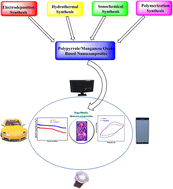Recent developments in polypyrrole/manganese oxide-based nanocomposites for thin film electrodes in supercapacitors: a minireview
Abstract
This review article highlights the recent developments in the synthesis and electrochemical performance of polypyrrole/manganese oxide thin-film electrodes synthesized by various chemical methods for supercapacitor applications. In the class of conducting polymers for electrode applications, polypyrrole (Ppy) is considered an important polymer due to its low cost and abundance. Ppy's polymeric composition and structural properties, however, pose stability concerns and have a drawback of a short life cycle over long-term charge–discharge processes, limiting its potential for industrial and commercial utilization. Recently, manganese oxide (MnO2) has been actively explored as a supercapacitor electrode material due to its low cost, high theoretical specific capacitance and abundance. Ppy/MnO2 thin film electrodes revealed high specific capacitance and stability, making them excellent candidates for next-generation supercapacitor electrode materials.

- This article is part of the themed collection: Recent Review Articles


 Please wait while we load your content...
Please wait while we load your content...